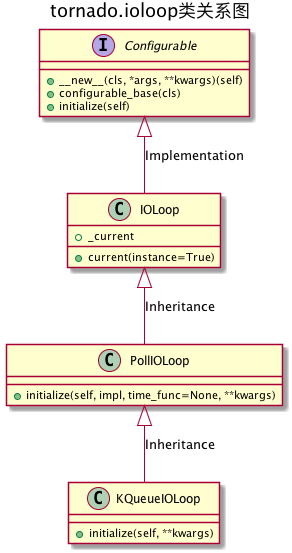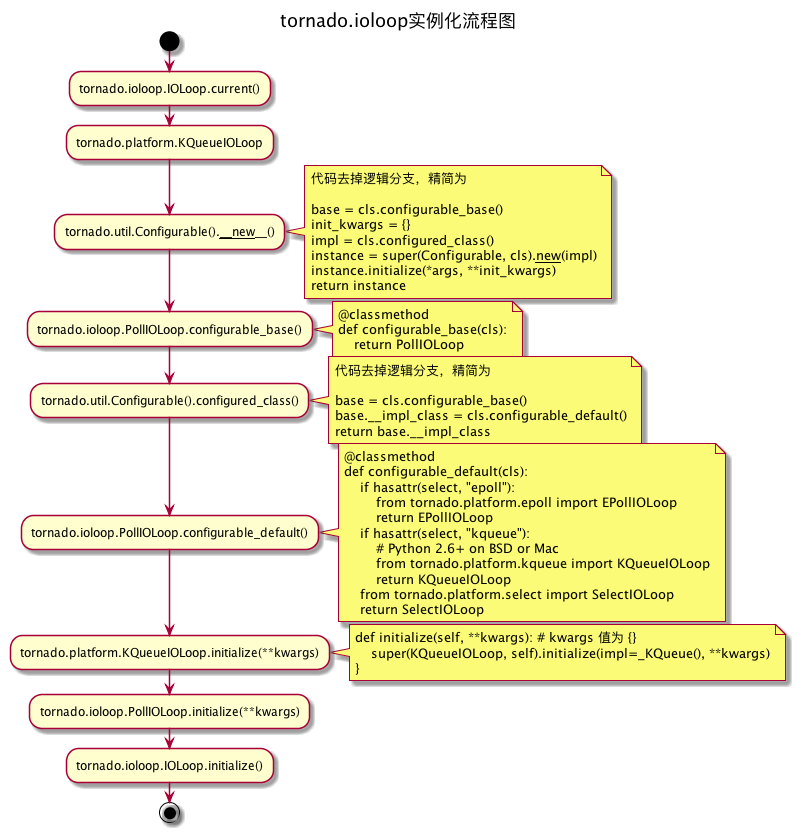前言
上一篇我们对Tornado的源码已经有了初版的了解,接下来重点分析和理解下tornado异步的实现。
tornado 优秀的大并发处理能力得益于它的 web server 从底层开始就自己实现了一整套基于 epoll 的单线程异步架构(其他 python web 框架的自带 server 基本是基于 wsgi 写的简单服务器,并没有自己实现底层结构)。那么 tornado.ioloop 就是 tornado web server 最底层的实现。
环境
- Python: Python 2.7.14
- 系统: macOS 10.13.4
分析依赖

platform模块比较容易引起关注,自身实现了selete, epoll Io多路复用。
准备知识
之前有整理过一篇IO多路复用机制的笔记,我们可以先不用了解这多,先记住以下几个核心点
- 1.epoll对文件描述符的操作有两种模式:水平触发 LT(level trigger)和边缘触发 ET(edge trigger),其中LT模式是默认模式。
- LT: 根据epoll_wait调用会重复通知
- ET: 不会重复通知,只通知一次,理论上边缘触发的性能要更高一些,但是代码实现相当复杂。
- 2.3种宏定义
| 宏定义 | 含义 |
|---|---|
| EPOLLIN | 缓冲区满,有数据可读 |
| EPOLLOUT | 缓冲区空,可写数据 |
| EPOLLERR | 发生错误 |
- 3.4种API
- epoll_create
- epoll_ctl
- epoll_wait
- close
官方hello world
#!/usr/bin/env python
# -*- coding: utf-8 -*-
"""
#=============================================================================
# ProjectName: seekplum
# FileName: ioloop_test
# Desc: 官方示例代码
# Author: seekplum
# Email: 1131909224m@sina.cn
# HomePage: seekplum.github.io
# Create: 2018-12-13 20:28
#=============================================================================
"""
import tornado.ioloop
import tornado.web
class MainHandler(tornado.web.RequestHandler):
def get(self):
self.write("Hello, world")
def make_app():
return tornado.web.Application([
(r"/", MainHandler),
])
if __name__ == "__main__":
app = make_app()
app.listen(8888)
tornado.ioloop.IOLoop.current().start()
疑问
前面的代码都好理解,最后的 tornado.ioloop.IOLoop.current().start() 为什么要加呢,启动端口监听后不就可以了吗?app和iolopp之间是如何关联的呢?
实践
- 1.先不改动代码,直接运行,命令行通过
curl http://127.0.0.1:8888可以看到返回了Hello, world - 2.去除最后一行
tornado.ioloop.IOLoop.current().start(),发现web server直接退出了。
小结
可见daemon服务是由最后一行实现的,可是还是无法解释前面的疑问,那我们继续分析。
查看源码
查看 current 返回值
@staticmethod
def current(instance=True):
"""Returns the current thread's `IOLoop`.
If an `IOLoop` is currently running or has been marked as
current by `make_current`, returns that instance. If there is
no current `IOLoop` and ``instance`` is true, creates one.
.. versionchanged:: 4.1
Added ``instance`` argument to control the fallback to
`IOLoop.instance()`.
.. versionchanged:: 5.0
On Python 3, control of the current `IOLoop` is delegated
to `asyncio`, with this and other methods as pass-through accessors.
The ``instance`` argument now controls whether an `IOLoop`
is created automatically when there is none, instead of
whether we fall back to `IOLoop.instance()` (which is now
an alias for this method). ``instance=False`` is deprecated,
since even if we do not create an `IOLoop`, this method
may initialize the asyncio loop.
"""
if asyncio is None:
current = getattr(IOLoop._current, "instance", None)
if current is None and instance:
current = IOLoop()
if IOLoop._current.instance is not current:
raise RuntimeError("new IOLoop did not become current")
else:
try:
loop = asyncio.get_event_loop()
except (RuntimeError, AssertionError):
if not instance:
return None
raise
try:
return IOLoop._ioloop_for_asyncio[loop]
except KeyError:
if instance:
from tornado.platform.asyncio import AsyncIOMainLoop
current = AsyncIOMainLoop(make_current=True)
else:
current = None
return current
使用Pycharm端点调试下,看下current返回的到底是什么

由此可知, tornado.ioloop.IOLoop.current() 最终返回的就是 tornado.platform.kqueue.KQueueIOLoop 类的实例化对象。
查看 KQueueIOLoop
class KQueueIOLoop(PollIOLoop):
def initialize(self, **kwargs):
super(KQueueIOLoop, self).initialize(impl=_KQueue(), **kwargs)
由代码可知,KQueueIOLoop 只实现了父类的 initialize 方法,那么 __init__, start 等方法肯定是由 PollIOLoop 实现的。继续看 PollIOLoop 代码

由图可知,实例化操作是由基类 Configurable中的 __new__ 方法完成的,初始化是由 initialize 方法完成的。
查看 Configurable 的 __new__ 方法
class Configurable(object):
"""Base class for configurable interfaces.
A configurable interface is an (abstract) class whose constructor
acts as a factory function for one of its implementation subclasses.
The implementation subclass as well as optional keyword arguments to
its initializer can be set globally at runtime with `configure`.
By using the constructor as the factory method, the interface
looks like a normal class, `isinstance` works as usual, etc. This
pattern is most useful when the choice of implementation is likely
to be a global decision (e.g. when `~select.epoll` is available,
always use it instead of `~select.select`), or when a
previously-monolithic class has been split into specialized
subclasses.
Configurable subclasses must define the class methods
`configurable_base` and `configurable_default`, and use the instance
method `initialize` instead of ``__init__``.
.. versionchanged:: 5.0
It is now possible for configuration to be specified at
multiple levels of a class hierarchy.
"""
__impl_class = None # type: type
__impl_kwargs = None # type: Dict[str, Any]
def __new__(cls, *args, **kwargs):
base = cls.configurable_base()
init_kwargs = {}
if cls is base:
impl = cls.configured_class()
if base.__impl_kwargs:
init_kwargs.update(base.__impl_kwargs)
else:
impl = cls
init_kwargs.update(kwargs)
if impl.configurable_base() is not base:
# The impl class is itself configurable, so recurse.
return impl(*args, **init_kwargs)
instance = super(Configurable, cls).__new__(impl)
# initialize vs __init__ chosen for compatibility with AsyncHTTPClient
# singleton magic. If we get rid of that we can switch to __init__
# here too.
instance.initialize(*args, **init_kwargs)
return instance
@classmethod
def configured_class(cls):
# type: () -> type
"""Returns the currently configured class."""
base = cls.configurable_base()
# Manually mangle the private name to see whether this base
# has been configured (and not another base higher in the
# hierarchy).
if base.__dict__.get('_Configurable__impl_class') is None:
base.__impl_class = cls.configurable_default()
return base.__impl_class
PollIOLoop类实现
class PollIOLoop(IOLoop):
"""Base class for IOLoops built around a select-like function.
For concrete implementations, see `tornado.platform.epoll.EPollIOLoop`
(Linux), `tornado.platform.kqueue.KQueueIOLoop` (BSD and Mac), or
`tornado.platform.select.SelectIOLoop` (all platforms).
"""
def initialize(self, impl, time_func=None, **kwargs):
super(PollIOLoop, self).initialize(**kwargs)
self._impl = impl
if hasattr(self._impl, 'fileno'):
set_close_exec(self._impl.fileno())
self.time_func = time_func or time.time
self._handlers = {}
self._events = {}
self._callbacks = collections.deque()
self._timeouts = []
self._cancellations = 0
self._running = False
self._stopped = False
self._closing = False
self._thread_ident = None
self._pid = os.getpid()
self._blocking_signal_threshold = None
self._timeout_counter = itertools.count()
# Create a pipe that we send bogus data to when we want to wake
# the I/O loop when it is idle
self._waker = Waker()
self.add_handler(self._waker.fileno(),
lambda fd, events: self._waker.consume(),
self.READ)
@classmethod
def configurable_base(cls):
return PollIOLoop
@classmethod
def configurable_default(cls):
if hasattr(select, "epoll"):
from tornado.platform.epoll import EPollIOLoop
return EPollIOLoop
if hasattr(select, "kqueue"):
# Python 2.6+ on BSD or Mac
from tornado.platform.kqueue import KQueueIOLoop
return KQueueIOLoop
from tornado.platform.select import SelectIOLoop
return SelectIOLoop
到现在可以梳理出 tornado.ioloop.IOLoop.current() 做了什么了,且看下图。

小结
根据上述流程图我们可以梳理出ioloop的实例化流程了。
- 1.tornado.ioloop.IOLoop.current() 方法返回 tornado.platform.kqueue._KQueue类实例化对象
- 2.tornado.platform.kqueue._KQueue的实例化由 tornado.util.COnfigurable().__new__方法完成
- 3.在__new__方法中通过做工厂函数获取了默认的configurable
- 4.tornado.ioloop.IOLoop.initalize() 方法完成了初始化操作
接下来重点看下 PollIOLoop 类中 initialize , start 两个方法做了什么。
PollIOLoop initialize方法
首先要看的是关于 epoll 操作的方法,还记得前文说过的 epoll 只需要四个 api 就能完全操作嘛?
我们来看 PollIOLoop 的实现:
def close(self, all_fds=False):
self._closing = True
self.remove_handler(self._waker.fileno())
if all_fds:
for fd, handler in list(self._handlers.values()):
self.close_fd(fd)
self._waker.close()
self._impl.close()
self._callbacks = None
self._timeouts = None
if hasattr(self, '_executor'):
self._executor.shutdown()
def add_handler(self, fd, handler, events):
fd, obj = self.split_fd(fd)
self._handlers[fd] = (obj, stack_context.wrap(handler))
self._impl.register(fd, events | self.ERROR)
def update_handler(self, fd, events):
fd, obj = self.split_fd(fd)
self._impl.modify(fd, events | self.ERROR)
def remove_handler(self, fd):
fd, obj = self.split_fd(fd)
self._handlers.pop(fd, None)
self._events.pop(fd, None)
try:
self._impl.unregister(fd)
except Exception:
gen_log.debug("Error deleting fd from IOLoop", exc_info=True)
epoll_ctl:这个三个方法分别对应 epoll_ctl 中的 add 、 modify 、 del 参数。 所以这三个方法实现了 epoll 的 epoll_ctl 。
epoll_create:然后 epoll 的生成在前文 EPollIOLoop 的初始化中就已经完成了:super(EPollIOLoop, self).initialize(impl=select.epoll(), **kwargs)。 这个相当于 epoll_create 。
epoll_wait:epoll_wait 操作则在 start() 中:event_pairs = self._impl.poll(poll_timeout)
epoll_close:而 epoll 的 close 则在 PollIOLoop 中的 close 方法内调用: self._impl.close() 完成。
initialize方法
class PollIOLoop(IOLoop):
"""Base class for IOLoops built around a select-like function.
For concrete implementations, see `tornado.platform.epoll.EPollIOLoop`
(Linux), `tornado.platform.kqueue.KQueueIOLoop` (BSD and Mac), or
`tornado.platform.select.SelectIOLoop` (all platforms).
"""
def initialize(self, impl, time_func=None, **kwargs):
super(PollIOLoop, self).initialize(**kwargs)
self._impl = impl # 指定 epoll,即 tornado.platform.kqueue._KQueue
if hasattr(self._impl, 'fileno'):
set_close_exec(self._impl.fileno()) # fork 后关闭无用文件描述符
self.time_func = time_func or time.time # 指定获取当前时间的函数
self._handlers = {} # handler 的字典,储存被 epoll 监听的 handler,与打开它的文件描述符 ( file descriptor 简称 fd ) 一一对应
self._events = {} # event 的字典,储存 epoll 返回的活跃的 fd event pairs
self._callbacks = collections.deque() # deque 是一个双端队列
self._timeouts = [] # 将是一个最小堆结构,按照超时时间从小到大排列的 fd 的任务堆( 通常这个任务都会包含一个 callback )
self._cancellations = 0 # 关于 timeout 的计数器
self._running = False # ioloop 是否在运行
self._stopped = False # ioloop 是否停止
self._closing = False # ioloop 是否关闭
self._thread_ident = None # 当前线程堆标识符 ( thread identify )
self._pid = os.getpid() # 获取当前进程id
self._blocking_signal_threshold = None # 系统信号, 主要用来在 epoll_wait 时判断是否会有 signal alarm 打断 epoll
self._timeout_counter = itertools.count() # 超时计数器
self._waker = Waker() # 一个 waker 类,主要是对于管道 pipe 的操作,因为 ioloop 属于底层的数据操作,这里 epoll 监听的是 pipe,是否违反了依赖导致原则?
self.add_handler(self._waker.fileno(),
lambda fd, events: self._waker.consume(),
self.READ) # 将管道加入 epoll 监听,对于 web server 初始化时只需要关心 READ 事件
通过__new__, initialize, make_current 等方式初始化目的是为了让 PollIOLoop 类是一个单例
PollIOLoop start方法
def start(self):
# 检查是否已经运行
if self._running:
raise RuntimeError("IOLoop is already running")
# 检查进程id是否发生了改变
if os.getpid() != self._pid:
raise RuntimeError("Cannot share PollIOLoops across processes")
# 设置日志配置
self._setup_logging()
# 修改停止状态为假
if self._stopped:
self._stopped = False
return
# 获取之前运行的ioloop
old_current = IOLoop.current(instance=False)
# 清空旧的ioloop,并设置为当前ioloop
if old_current is not self:
self.make_current()
# 获取线程id
self._thread_ident = thread.get_ident()
# 设置状态为运行
self._running = True
# signal.set_wakeup_fd closes a race condition in event loops:
# a signal may arrive at the beginning of select/poll/etc
# before it goes into its interruptible sleep, so the signal
# will be consumed without waking the select. The solution is
# for the (C, synchronous) signal handler to write to a pipe,
# which will then be seen by select.
#
# In python's signal handling semantics, this only matters on the
# main thread (fortunately, set_wakeup_fd only works on the main
# thread and will raise a ValueError otherwise).
#
# If someone has already set a wakeup fd, we don't want to
# disturb it. This is an issue for twisted, which does its
# SIGCHLD processing in response to its own wakeup fd being
# written to. As long as the wakeup fd is registered on the IOLoop,
# the loop will still wake up and everything should work.
old_wakeup_fd = None
# 检查系统类型是否为linux
if hasattr(signal, 'set_wakeup_fd') and os.name == 'posix':
# requires python 2.6+, unix. set_wakeup_fd exists but crashes
# the python process on windows.
try:
old_wakeup_fd = signal.set_wakeup_fd(self._waker.write_fileno())
if old_wakeup_fd != -1:
# Already set, restore previous value. This is a little racy,
# but there's no clean get_wakeup_fd and in real use the
# IOLoop is just started once at the beginning.
signal.set_wakeup_fd(old_wakeup_fd)
old_wakeup_fd = None
except ValueError:
# Non-main thread, or the previous value of wakeup_fd
# is no longer valid.
old_wakeup_fd = None
try:
# 服务正式启动
while True:
# 下一次回调事件次数
ncallbacks = len(self._callbacks)
# 维护回调事件超时的任务
due_timeouts = []
# 判断 _timeouts 里是否有数据
if self._timeouts:
# 获取当前时间,用来判断 _timeouts 里的任务有没有超时
now = self.time()
# _timeouts 有数据时一直循环, _timeouts 是个最小堆,
# 第一个数据永远是最小的, 这里第一个数据永远是最接近超时或已超时的
while self._timeouts:
# 超时任务被取消了
if self._timeouts[0].callback is None:
# 直接在队列中删除
heapq.heappop(self._timeouts)
# 超时计数器 -1
self._cancellations -= 1
elif self._timeouts[0].deadline <= now:
due_timeouts.append(heapq.heappop(self._timeouts))
else:
break
# 队列长度超过 512 , 且超过一半取消时
if (self._cancellations > 512 and
self._cancellations > (len(self._timeouts) >> 1)):
self._cancellations = 0
self._timeouts = [x for x in self._timeouts
if x.callback is not None]
# 进行 _timeouts 最小堆化
heapq.heapify(self._timeouts)
# 运行 callbacks 里所有的 calllback
for i in range(ncallbacks):
self._run_callback(self._callbacks.popleft())
# 运行所有已过期任务的 callback
for timeout in due_timeouts:
if timeout.callback is not None:
self._run_callback(timeout.callback)
# 释放闭包占用的内存
due_timeouts = timeout = None
# _callbacks 里有数据时
if self._callbacks:
# 有任何回调或超时调用 add_callback,则运行前不等待
poll_timeout = 0.0
# _timeouts 里有数据时
elif self._timeouts:
# 使用第一个超时回调时间作为超时时间
poll_timeout = self._timeouts[0].deadline - self.time()
# 如果最小过期时间大于默认等待时间 _POLL_TIMEOUT = 3600,
# 则用 3600,如果最小过期时间小于0 就设置为0 立即返回。
poll_timeout = max(0, min(poll_timeout, _POLL_TIMEOUT))
else:
# 没有超时和没有回调,所以使用默认值 3600
poll_timeout = _POLL_TIMEOUT
# 检查是否有系统信号中断运行,有则中断,无则继续
if not self._running:
break
# 开始 epoll_wait 之前确保 signal alarm 都被清空
# 这样在 epoll_wait 过程中不会被 signal alarm 打断
if self._blocking_signal_threshold is not None:
signal.setitimer(signal.ITIMER_REAL, 0, 0)
try:
# 获取返回的活跃事件队
event_pairs = self._impl.poll(poll_timeout)
except Exception as e:
# 不同Python版本和IOLoop实现会抛出不同异常,
# 但忽略 EINTR 异常
if errno_from_exception(e) == errno.EINTR:
continue
else:
raise
# epoll_wait 结束, 再设置 signal alarm
if self._blocking_signal_threshold is not None:
signal.setitimer(signal.ITIMER_REAL,
self._blocking_signal_threshold, 0)
# 将活跃事件加入 _events
self._events.update(event_pairs)
while self._events:
fd, events = self._events.popitem()
try:
fd_obj, handler_func = self._handlers[fd]
handler_func(fd_obj, events)
except (OSError, IOError) as e:
if errno_from_exception(e) == errno.EPIPE:
# 客户端关闭连接时发生
pass
else:
self.handle_callback_exception(self._handlers.get(fd))
except Exception:
self.handle_callback_exception(self._handlers.get(fd))
fd_obj = handler_func = None
finally:
# reset the stopped flag so another start/stop pair can be issued
# 确保发生异常也继续运行
self._stopped = False
# 清空 signal alarm
if self._blocking_signal_threshold is not None:
signal.setitimer(signal.ITIMER_REAL, 0, 0)
if old_current is None:
IOLoop.clear_current()
elif old_current is not self:
old_current.make_current()
if old_wakeup_fd is not None:
signal.set_wakeup_fd(old_wakeup_fd)
除了注释中的解释,还有几点补充:
close_exec 的作用: 子进程在fork出来的时候,使用了写时复制(COW,Copy-On-Write)方式获得父进程的数据空间、 堆和栈副本,这其中也包括文件描述符。刚刚fork成功时,父子进程中相同的文件描述符指向系统文件表中的同一项,接着,一般我们会调用exec执行另一个程序,此时会用全新的程序替换子进程的正文,数据,堆和栈等。此时保存文件描述符的变量当然也不存在了,我们就无法关闭无用的文件描述符了。所以通常我们会fork子进程后在子进程中直接执行close关掉无用的文件描述符,然后再执行exec。 所以 close_exec 执行的其实就是 关闭 + 执行的作用。 详情可以查看: 关于linux进程间的close-on-exec机制 — (说明: 这一段直接是抄的致谢中的博客)
Waker(): Waker 封装了对于管道 pipe 的操作:
from __future__ import absolute_import, division, print_function
import fcntl
import os
from tornado.platform import common, interface
def set_close_exec(fd):
flags = fcntl.fcntl(fd, fcntl.F_GETFD)
fcntl.fcntl(fd, fcntl.F_SETFD, flags | fcntl.FD_CLOEXEC)
def _set_nonblocking(fd):
flags = fcntl.fcntl(fd, fcntl.F_GETFL)
fcntl.fcntl(fd, fcntl.F_SETFL, flags | os.O_NONBLOCK)
class Waker(interface.Waker):
def __init__(self):
r, w = os.pipe()
_set_nonblocking(r)
_set_nonblocking(w)
set_close_exec(r)
set_close_exec(w)
self.reader = os.fdopen(r, "rb", 0)
self.writer = os.fdopen(w, "wb", 0)
def fileno(self):
return self.reader.fileno()
def write_fileno(self):
return self.writer.fileno()
def wake(self):
try:
self.writer.write(b"x")
except (IOError, ValueError):
pass
def consume(self):
try:
while True:
result = self.reader.read()
if not result:
break
except IOError:
pass
def close(self):
self.reader.close()
common.try_close(self.writer)
可以看到 waker 把 pipe 分为读、 写两个管道并都设置了非阻塞和 close_exec。 注意wake(self)方法中:self.writer.write(b”x”) 直接向管道中写入随意字符从而释放管道。
总结
- 1.
tornado.ioloop.IOLoop.current().start()为什么要加呢,启动端口监听后不就可以了吗?- Application 主要是实现路由功能,启动监听端口后还需要轮询监听事件
- 2.app和iolopp之间是如何关联的呢?
- 应用程序监听端口后,通过
PollIOLoop类执行start方法后,会在1048行event_pairs = self._impl.poll(poll_timeout)等待请求(self._impl 就是 tornado.platform.kqueue._KQueue类实例化对象)。
- 应用程序监听端口后,通过
def poll(self, timeout):
# 去检测已经注册了的文件描述符。会返回一个可能为空的list,
# list中包含着(fd, event)这样的二元组。
# fd是文件描述符, event是文件描述符对应的事件。
# 如果返回的是一个空的list,则说明超时了且没有文件描述符有事件发生。
# timeout的单位是milliseconds,如果设置了timeout,系统将会等待对应的时间。
# 如果timeout缺省或者是None,这个方法将会阻塞直到对应的poll对象有一个事件发生。
kevents = self._kqueue.control(None, 1000, timeout)
events = {}
for kevent in kevents:
fd = kevent.ident
if kevent.filter == select.KQ_FILTER_READ:
events[fd] = events.get(fd, 0) | IOLoop.READ
if kevent.filter == select.KQ_FILTER_WRITE:
if kevent.flags & select.KQ_EV_EOF:
# If an asynchronous connection is refused, kqueue
# returns a write event with the EOF flag set.
# Turn this into an error for consistency with the
# other IOLoop implementations.
# Note that for read events, EOF may be returned before
# all data has been consumed from the socket buffer,
# so we only check for EOF on write events.
events[fd] = IOLoop.ERROR
else:
events[fd] = events.get(fd, 0) | IOLoop.WRITE
if kevent.flags & select.KQ_EV_ERROR:
events[fd] = events.get(fd, 0) | IOLoop.ERROR
return events.items()
后续
阅读了ioloop的实现源码,有了初步的理解和印象,还需要学习tornado中异步是如何使用ioloop来加深印象和验证理解。
各位看官下篇见!

